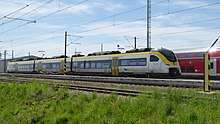Siemens Mireo
The Siemens Mireo is a family of electric multiple units (EMU) designed by Siemens Mobility. It is designed to be a successor to the "Mainline" variant of the company's Desiro EMUs.[1]

The railcars have an articulated design and aluminum carbodies, with 26 metres (85 ft) cab cars on each end of a trainset and 19 metres (62 ft) passenger cars between them, with trainsets between two and seven cars long.[1] The use of aluminum, combined with new control systems, is intended to reduce energy use by up to 25%. compared to previous Siemens EMUs.[2] The railcars can reach a top speed of up to 160 kilometres per hour (99 mph).[1] Siemens Mobility is currently working on a hydrogen fuel cell prototype[3].
Siemens introduced the first Mireo railcars at the 2016 InnoTrans trade fair.[1] The first units were ordered in February 2017 by DB Regio, which ordered 24 three-car trainsets with a passenger capacity of 220 for service on its routes in the Rhine valley in southwestern Germany.[2] DB Regio ordered a further 57 three-car high-density sets for S-Bahn service.[3][4] Production of Mireo trainsets began in 2018, with the first completed set unveiled in early December.[4][5] Following testing, Mireo trains are expected to enter revenue service in June 2020.[5]
References
- "Siemens to unveil Mireo modular EMU concept". Railway Gazette. 30 June 2016. Retrieved 17 February 2017.
- "DB Regio places first order for Siemens Mireo". Railway Gazette. 17 February 2017. Retrieved 17 February 2017.
- "Mireo EMU unveiled by Siemens". International Railway Journal. 2018-12-06. Retrieved 2019-08-06.
- "Assembly of first Siemens Mireo EMU underway". Railway Gazette. 5 June 2018. Retrieved 6 June 2018.
- "Siemens presents first Mireo EMU". Railway Gazette International. 7 December 2018. Retrieved 28 December 2018.